weight INFINITI QX30 2019 Towing Guide
[x] Cancel search | Manufacturer: INFINITI, Model Year: 2019, Model line: QX30, Model: INFINITI QX30 2019Pages: 25, PDF Size: 0.38 MB
Page 14 of 25
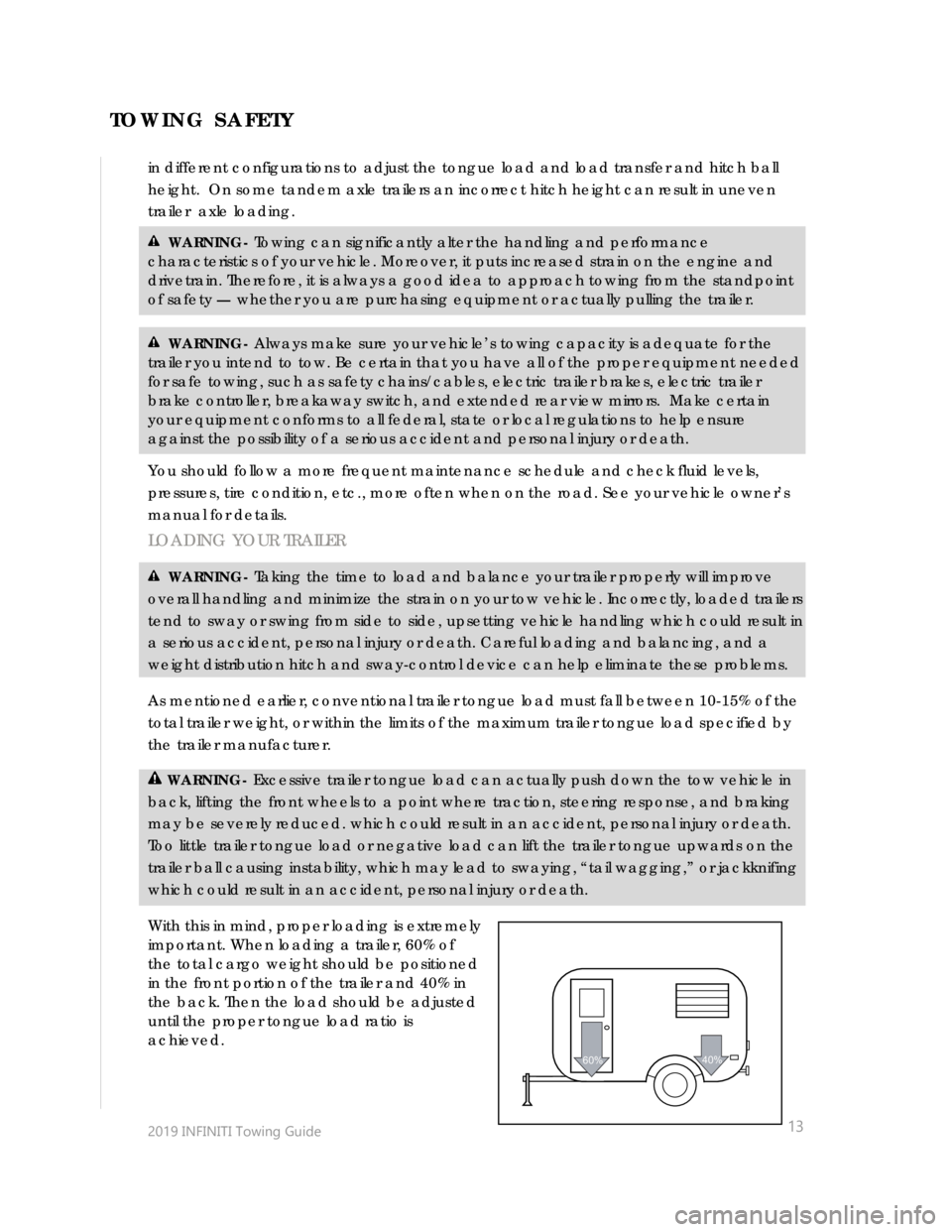
2019 INFINITI Towing Guide
13
in different configurations to adjust the tongue load and load transfer and hitch ball
height. On some tandem axle trailers an incorrect hitch height can result in uneven
trailer axle loading.
WARNING- Towing can significantly alter the handling and performance
characteristics of your vehicle. Moreover, it puts increased strain on the engine and
drivetrain. Therefore, it is always a good idea to approach towing from the standpoint
of safety — whether you are purchasing equipment or actually pulling the trailer.
WARNING- Always make sure your vehicle’s towing capacity is adequate for the
trailer you intend to tow. Be certain that you have all of the proper equipment needed
for safe towing, such as safety chains/cables, electric trailer brakes, electric trailer
brake controller, breakaway switch, and extended rear view mirrors. Make certain
your equipment conforms to all federal, state or local regulations to help ensure
against the possibility of a serious accident and personal injury or death.
You should follow a more frequent maintenance schedule and check fluid levels,
pressures, tire condition, etc., more often when on the road. See your vehicle owner’s
manual for details.
LOADING YOUR TRAILER
WARNING- Taking the time to load and balance your trailer properly will improve
overall handling and minimize the strain on your tow vehicle. Incorrectly, loaded trailers
tend to sway or swing from side to side, upsetting vehicle handling which could result in
a serious accident, personal injury or death. Careful loading and balancing, and a
weight distribution hitch and sway-control device can help eliminate these problems.
As mentioned earlier, conventional trailer tongue load must fall between 10-15% of the
total trailer weight, or within the limits of the maximum trailer tongue load specified by
the trailer manufacturer.
WARNING- Excessive trailer tongue load can actually push down the tow vehicle in
back, lifting the front wheels to a point where traction, steering response, and braking
may be severely reduced. which could result in an accident, personal injury or death.
Too little trailer tongue load or negative load can lift the trailer tongue upwards on the
trailer ball causing instability, which may lead to swaying, “tail wagging,” or jackknifing
which could result in an accident, personal injury or death.
With this in mind, proper loading is extremely
important. When loading a trailer, 60% of
the total cargo weight should be positioned
in the front portion of the trailer and 40% in
the back. Then the load should be adjusted
until the proper tongue load ratio is
achieved.
60%40%
TOWING SAFETY
Page 15 of 25
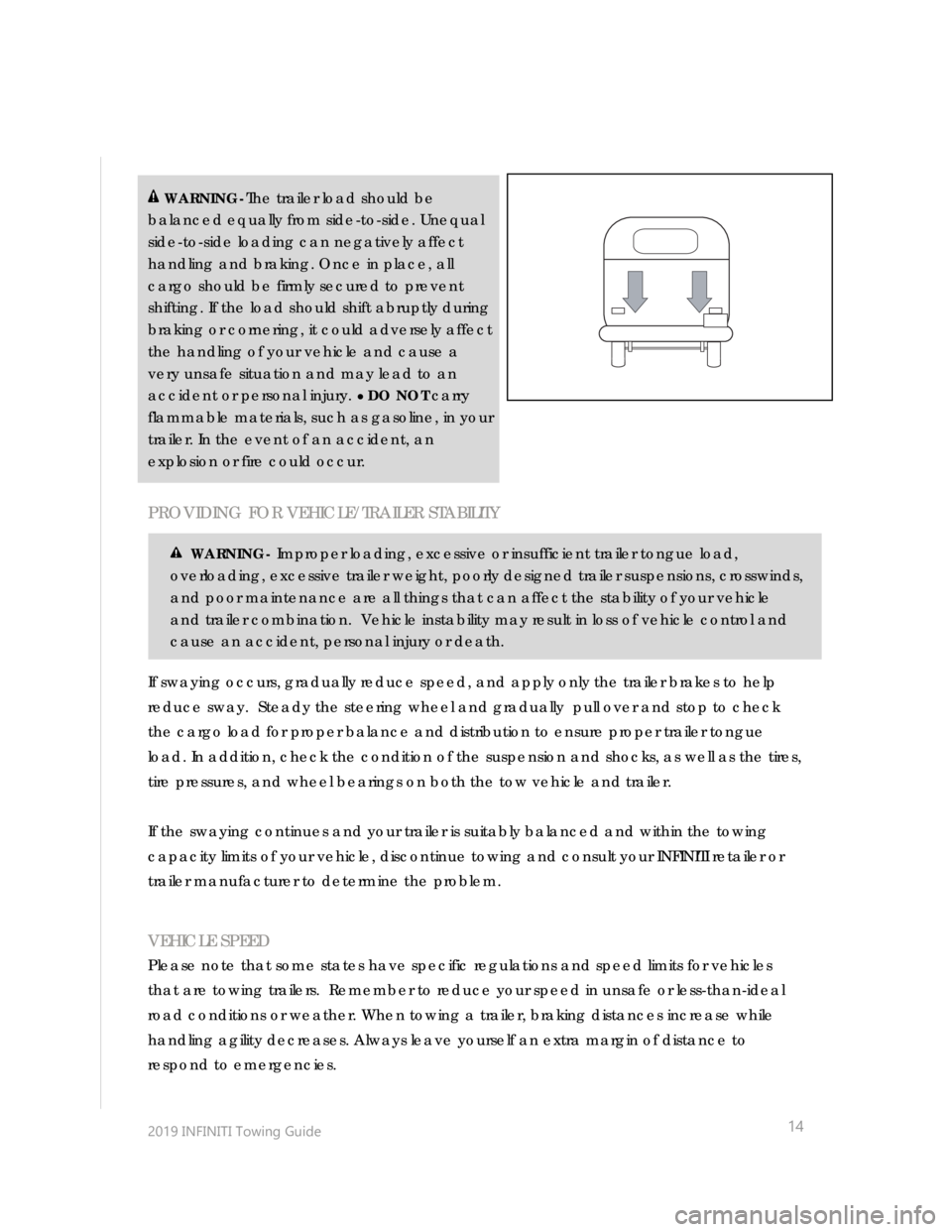
2019 INFINITI Towing Guide
14
WARNING-The trailer load should be
balanced equally from side-to-side. Unequal
side-to-side loading can negatively affect
handling and braking. Once in place, all
cargo should be firmly secured to prevent
shifting. If the load should shift abruptly during
braking or cornering, it could adversely affect
the handling of your vehicle and cause a
very unsafe situation and may lead to an
accident or personal injury.
● DO NOT carry
flammable materials, such as gasoline, in your
trailer. In the event of an accident, an
explosion or fire could occur.
PROVIDING FOR VEHICLE/TRAILER STABILITY
WARNING- Improper loading, excessive or insufficient trailer tongue load,
overloading, excessive trailer weight, poorly designed trailer suspensions, crosswinds,
and poor maintenance are all things that can affect the stability of your vehicle
and trailer combination. Vehicle instability may result in loss of vehicle control and
cause an accident, personal injury or death.
If swaying occurs, gradually reduce speed, and apply only the trailer brakes to help
reduce sway. Steady the steering wheel and gradually pull over and stop to check
the cargo load for proper balance and distribution to ensure proper trailer tongue
load. In addition, check the condition of the suspension and shocks, as well as the tires,
tire pressures, and wheel bearings on both the tow vehicle and trailer.
If the swaying continues and your trailer is suitably balanced and within the towing
capacity limits of your vehicle, discontinue towing and consult your INFINITI retailer or
trailer manufacturer to determine the problem.
VEHICLE SPEED
Please note that some states have specific regulations and speed limits for vehicles
that are towing trailers. Remember to reduce your speed in unsafe or less-than-ideal
road conditions or weather. When towing a trailer, braking distances increase while
handling agility decreases. Always leave yourself an extra margin of distance to
respond to emergencies.
Page 16 of 25
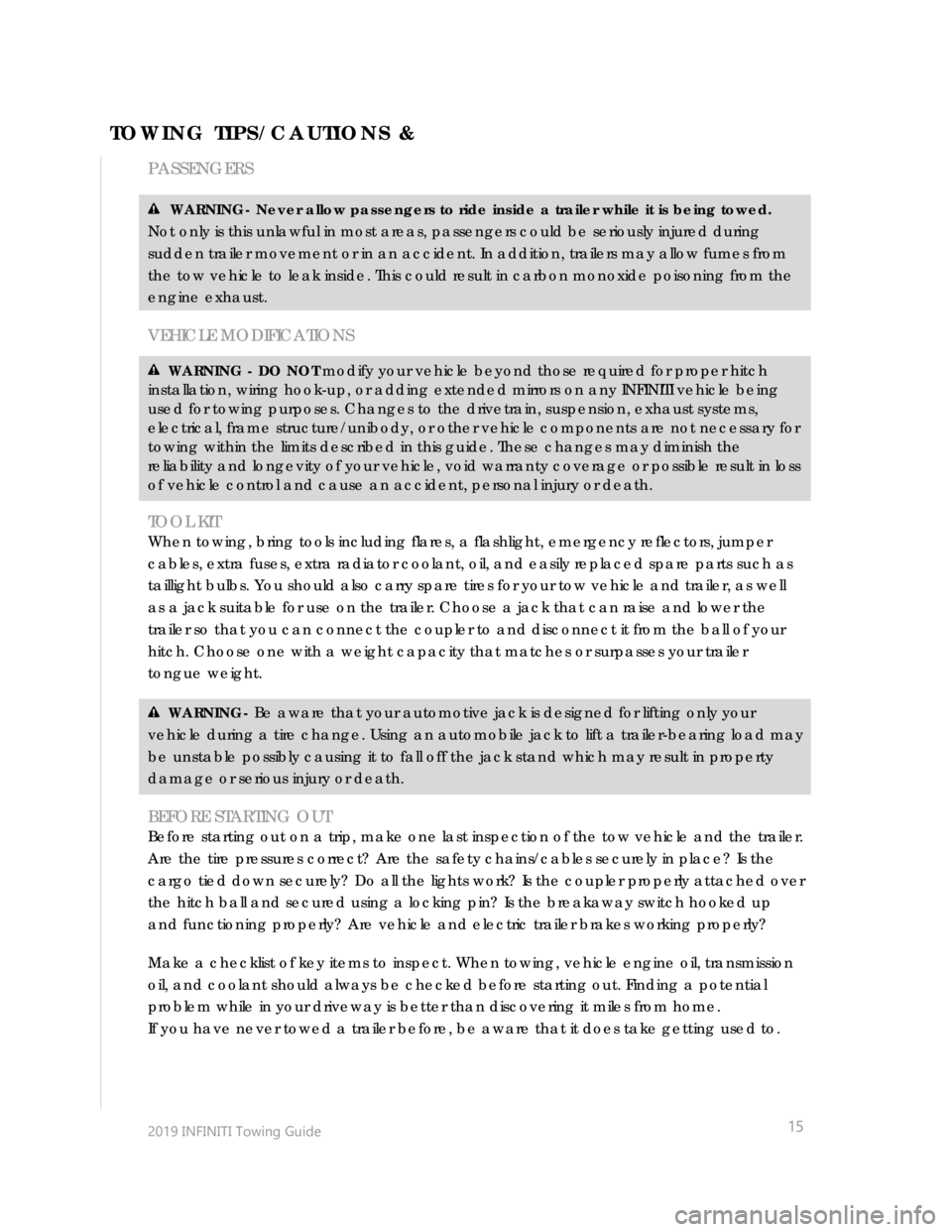
2019 INFINITI Towing Guide
15
PASSENGERS
WARNING- Never allow passengers to ride inside a trailer while it is being towed.
Not only is this unlawful in most areas, passengers could be seriously injured during
sudden trailer movement or in an accident. In addition, trailers may allow fumes from
the tow vehicle to leak inside. This could result in carbon monoxide poisoning from the
engine exhaust.
VEHICLE MODIFICATIONS
WARNING - DO NOT modify your vehicle beyond those required for proper hitch
installation, wiring hook-up, or adding extended mirrors on any INFINITI vehicle being
used for towing purposes. Changes to the drivetrain, suspension, exhaust systems,
electrical, frame structure/unibody, or other vehicle components are not necessary for
towing within the limits described in this guide. These changes may diminish the
reliability and longevity of your vehicle, void warranty coverage or possible result in loss
of vehicle control and cause an accident, personal injury or death.
TOOL KIT
When towing, bring tools including flares, a flashlight, emergency reflectors, jumper
cables, extra fuses, extra radiator coolant, oil, and easily replaced spare parts such as
taillight bulbs. You should also carry spare tires for your tow vehicle and trailer, as well
as a jack suitable for use on the trailer. Choose a jack that can raise and lower the
trailer so that you can connect the coupler to and disconnect it from the ball of your
hitch. Choose one with a weight capacity that matches or surpasses your trailer
tongue weight.
WARNING- Be aware that your automotive jack is designed for lifting only your
vehicle during a tire change. Using an automobile jack to lift a trailer-bearing load may
be unstable possibly causing it to fall off the jack stand which may result in property
damage or serious injury or death.
BEFORE STARTING OUT
Before starting out on a trip, make one last inspection of the tow vehicle and the trailer.
Are the tire pressures correct? Are the safety chains/cables securely in place? Is the
cargo tied down securely? Do all the lights work? Is the coupler properly attached over
the hitch ball and secured using a locking pin? Is the breakaway switch hooked up
and functioning properly? Are vehicle and electric trailer brakes working properly?
Make a checklist of key items to inspect. When towing, vehicle engine oil, transmission
oil, and coolant should always be checked before starting out. Finding a potential
problem while in your driveway is better than discovering it miles from home.
If you have never towed a trailer before, be aware that it does take getting used to.
TOWING TIPS/CAUTIONS &
Page 18 of 25
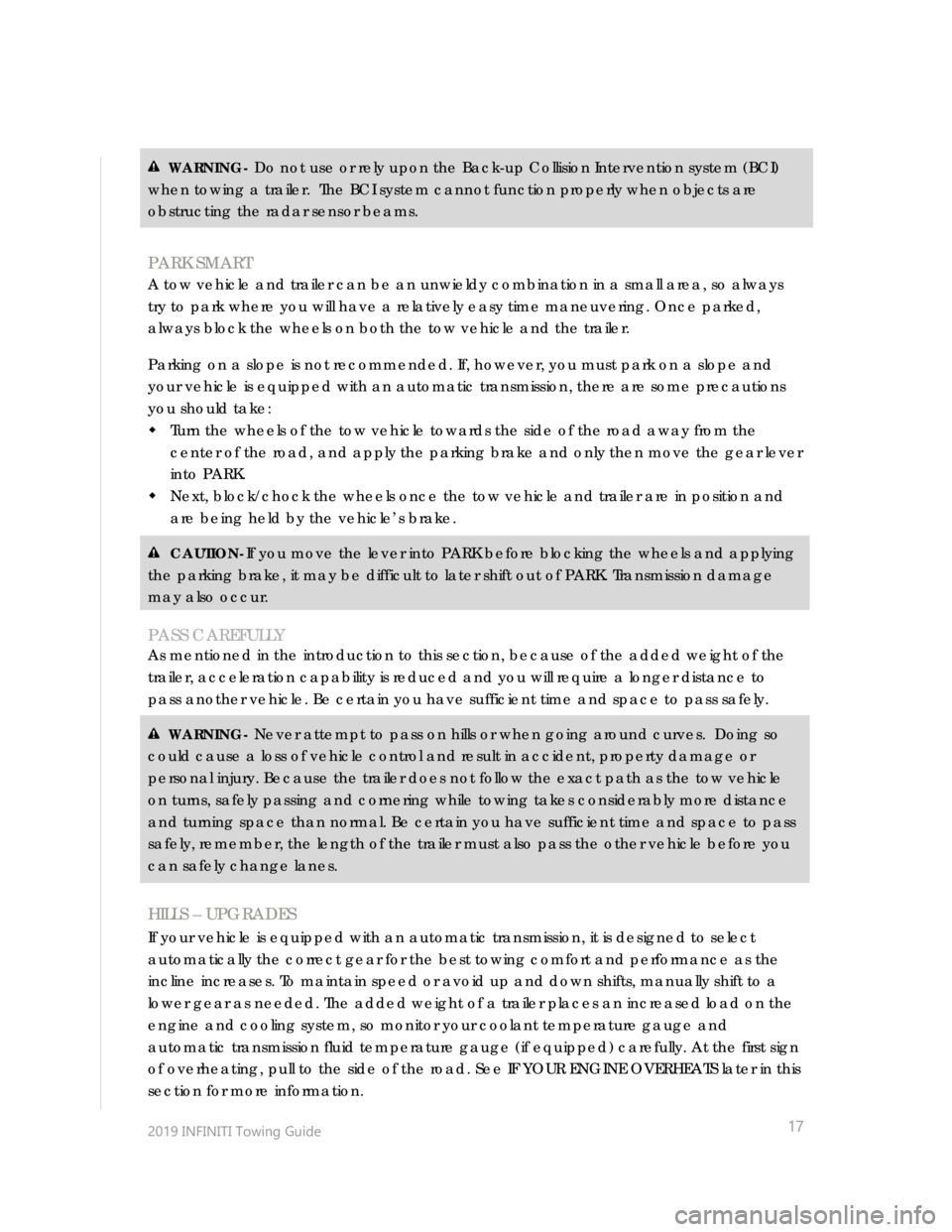
2019 INFINITI Towing Guide
17
WARNING- Do not use or rely upon the Back-up Collision Intervention system (BCI)
when towing a trailer. The BCI system cannot function properly when objects are
obstructing the radar sensor beams.
PARK SMART
A tow vehicle and trailer can be an unwieldy combination in a small area, so always
try to park where you will have a relatively easy time maneuvering. Once parked,
always block the wheels on both the tow vehicle and the trailer.
Parking on a slope is not recommended. If, however, you must park on a slope and
your vehicle is equipped with an automatic transmission, there are some precautions
you should take:
Turn the wheels of the tow vehicle towards the side of the road away from the
center of the road, and apply the parking brake and only then move the gear lever
into PARK.
Next, block/chock the wheels once the tow vehicle and trailer are in position and
are being held by the vehicle’s brake.
CAUTION-If you move the lever into PARK before blocking the wheels and applying
the parking brake, it may be difficult to later shift out of PARK. Transmission damage
may also occur.
PASS CAREFULLY
As mentioned in the introduction to this section, because of the added weight of the
trailer, acceleration capability is reduced and you will require a longer distance to
pass another vehicle. Be certain you have sufficient time and space to pass safely.
WARNING- Never attempt to pass on hills or when going around curves. Doing so
could cause a loss of vehicle control and result in accident, property damage or
personal injury. Because the trailer does not follow the exact path as the tow vehicle
on turns, safely passing and cornering while towing takes considerably more distance
and turning space than normal. Be certain you have sufficient time and space to pass
safely, remember, the length of the trailer must also pass the other vehicle before you
can safely change lanes.
HILLS – UPGRADES
If your vehicle is equipped with an automatic transmission, it is designed to select
automatically the correct gear for the best towing comfort and performance as the
incline increases. To maintain speed or avoid up and down shifts, manually shift to a
lower gear as needed. The added weight of a trailer places an increased load on the
engine and cooling system, so monitor your coolant temperature gauge and
automatic transmission fluid temperature gauge (if equipped) carefully. At the first sign
of overheating, pull to the side of the road. See IF YOUR ENGINE OVERHEATS later in this
section for more information.
Page 19 of 25
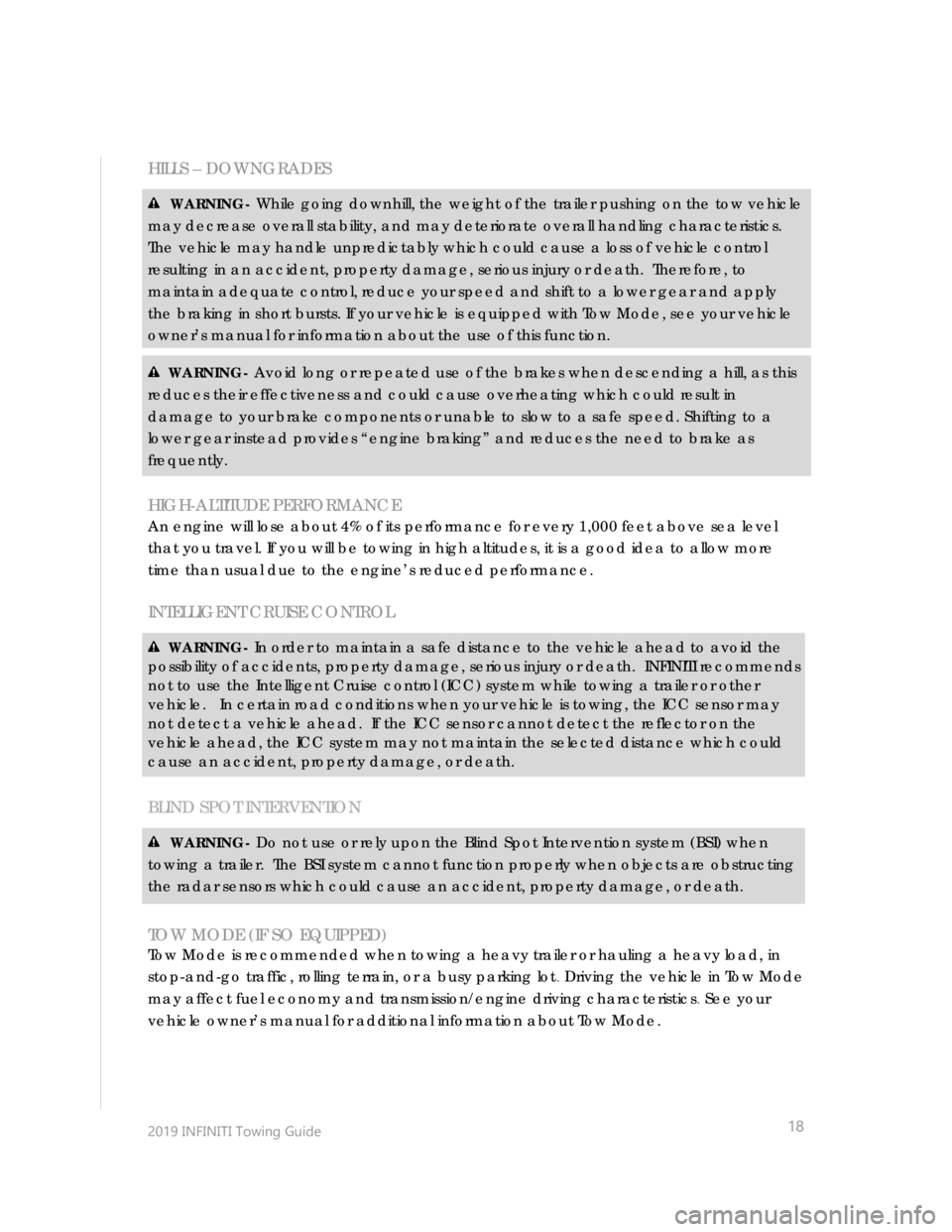
2019 INFINITI Towing Guide
18
HILLS – DOWNGRADES
WARNING- While going downhill, the weight of the trailer pushing on the tow vehicle
may decrease overall stability, and may deteriorate overall handling characteristics.
The vehicle may handle unpredictably which could cause a loss of vehicle control
resulting in an accident, property damage, serious injury or death. Therefore, to
maintain adequate control, reduce your speed and shift to a lower gear and apply
the braking in short bursts. If your vehicle is equipped with Tow Mode, see your vehicle
owner’s manual for information about the use of this function.
WARNING- Avoid long or repeated use of the brakes when descending a hill, as this
reduces their effectiveness and could cause overheating which could result in
damage to your brake components or unable to slow to a safe speed. Shifting to a
lower gear instead provides “engine braking” and reduces the need to brake as
frequently.
HIGH-ALTITUDE PERFORMANCE
An engine will lose about 4% of its performance for every 1,000 feet above sea level
that you travel. If you will be towing in high altitudes, it is a good idea to allow more
time than usual due to the engine’s reduced performance.
INTELLIGENT CRUISE CONTROL
WARNING- In order to maintain a safe distance to the vehicle ahead to avoid the
possibility of accidents, property damage, serious injury or death. INFINITI recommends
not to use the Intelligent Cruise control (ICC) system while towing a trailer or other
vehicle. In certain road conditions when your vehicle is towing, the ICC sensor may
not detect a vehicle ahead. If the ICC sensor cannot detect the reflector on the
vehicle ahead, the ICC system may not maintain the selected distance which could
cause an accident, property damage, or death.
BLIND SPOT INTERVENTION
WARNING- Do not use or rely upon the Blind Spot Intervention system (BSI) when
towing a trailer. The BSI system cannot function properly when objects are obstructing
the radar sensors which could cause an accident, property damage, or death.
TOW MODE (IF SO EQUIPPED)
Tow Mode is recommended when towing a heavy trailer or hauling a heavy load, in
stop-and-go traffic, rolling terrain, or a busy parking lot. Driving the vehicle in Tow Mode
may affect fuel economy and transmission/engine driving characteristics. See your
vehicle owner’s manual for additional information about Tow Mode.
Page 21 of 25
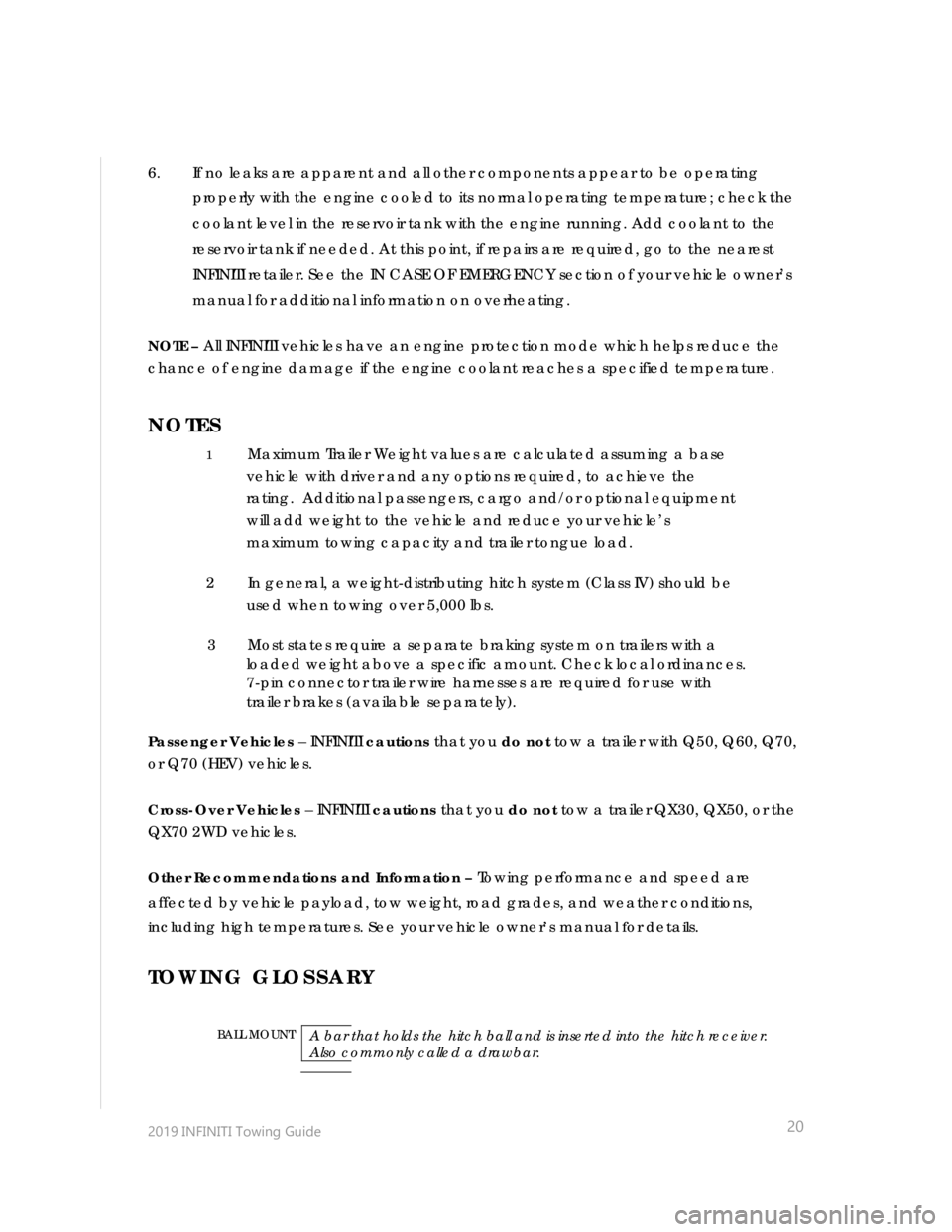
2019 INFINITI Towing Guide
20 6. If no leaks are apparent and all other components appear to be operating
properly with the engine cooled to its normal operating temperature; check the
coolant level in the reservoir tank with the engine running. Add coolant to the
reservoir tank if needed. At this point, if repairs are required, go to the nearest
INFINITI retailer. See the IN CASE OF EMERGENCY section of your vehicle owner’s
manual for additional information on overheating.
NOTE – All INFINITI vehicles have an engine protection mode which helps reduce the
chance of engine damage if the engine coolant reaches a specified temperature.
NOTES
Passenger Vehicles – INFINITI cautions that you do not tow a trailer with Q50, Q60, Q70,
or Q70 (HEV) vehicles.
Cross-Over Vehicles – INFINITI cautions that you do not tow a trailer QX30, QX50, or the
QX70 2WD vehicles.
Other Recommendations and Information – Towing performance and speed are
affected by vehicle payload, tow weight, road grades, and weather conditions,
including high temperatures. See your vehicle owner’s manual for details.
TOWING GLOSSARY
BALL MOUNT A bar that holds the hitch ball and is inserted into the hitch receiver.
Also commonly called a drawbar.
1 Maximum Trailer Weight values are calculated assuming a base
vehicle with driver and any options required, to achieve the
rating. Additional passengers, cargo and/or optional equipment
will add weight to the vehicle and reduce your vehicle’s
maximum towing capacity and trailer tongue load.
2 In general, a weight-distributing hitch system (Class IV) should be
used when towing over 5,000 lbs.
3 Most states require a separate braking system on trailers with a
loaded weight above a specific amount. Check local ordinances.
7-pin connector trailer wire harnesses are required for use with
trailer brakes (available separately).
Page 22 of 25

2019 INFINITI Towing Guide
21
BREAKAWAY SWITCH A safety device using a trailer battery that automatically applies the trailer’s
brakes if it should accidentally become separated from the tow vehicle.
A breakaway switch may be used with both electric or surge trailer brake
systems.
BUMPER HITCH A reinforced bumper designed to accommodate a hitch ball.
ELECTRIC TRAILER
BRAKES When the brakes on a tow vehicle are applied, an electric current is sent to
an actuator which applies the trailer’s brakes.
ELECTRIC TRAILER
BRAKE CONTROLLER A device that controls the electric trailer brakes.
GROSS AXLE
WEIGHT RATING
(GAWR) The maximum amount of weight each vehicle axle (front and rear) is
designed to safely carry.
GROSS COMBINED
WEIGHT RATING
(GCWR) The maximum allowable combined weight of the vehicle and trailer,
including passengers and all cargo.
GROSS VEHICLE
WEIGHT RATING
(GVWR) The maximum allowable weight of the vehicle, including passengers, cargo,
fuel, hitch, trailer tongue load, and any optional equipment.
HITCH BALL
A ball that connects the trailer to the tow vehicle hitch that provides the
means by which the trailer pivots during cornering. Available in a number of
sizes and weight capacities, it must correspond to the trailer coupler size, and
have a sufficient capacity rating for the trailer being pulled.
RECEIVER HITCH A frame- or structure-mounted hitch with a receiver that allows removal of the
ball mount.
SAFETY CHAINS/CABLES Provides an emergency connection between the tow vehicle and the trailer,
should the trailer become disengaged for any reason.
SURGE BRAKES
Hydraulic-type braking system activated by inertia. As the tow vehicle begins
to brake, the trailer pushes against the hitch ball, consequently activating the
trailer brakes.
TRAILER
TONGUE/COUPLER The part of the trailer that extends forward to meet the tow vehicle, and
carries the coupler assembly.
TRAILER TONGUE
LOAD The amount of trailer weight pressing down on the hitch.
WEIGHT-DISTRIBUTING
HITCH SYSTEM Type of hitch system that helps shift the trailer tongue weight to all trailer tires
and the tow vehicle front tires. Strongly recommended when towing trailers
with a Maximum Trailer Weight greater than 5,000 lbs.
WIRING HARNESS
Provides an electrical connection linking the tow vehicle’s electrical system to
the trailer’s system.